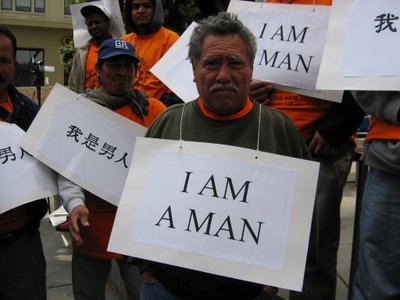 I commonly ask my Ethnic Studies students at San Francisco State to explain the origins of May Day and Cinco de Mayo. And, almost always no one ever has any consciousness of the history of either day. This is particularly frustrating to me since both holidays were born out of struggles here in the US - the militant labor movement of the 1880's and the Chicano Movimiento of the 1960's.
I commonly ask my Ethnic Studies students at San Francisco State to explain the origins of May Day and Cinco de Mayo. And, almost always no one ever has any consciousness of the history of either day. This is particularly frustrating to me since both holidays were born out of struggles here in the US - the militant labor movement of the 1880's and the Chicano Movimiento of the 1960's.Ironically, SF's Indy Media is reporting today that racist/anti-immigrant groups are desecrating Cinco de Mayo by holding "anti-illegal immigrant" rallies on May 5 and 6 in the San Jose area. The mainstream media reports of the historic May 1st rallies and marches throughout the United States barely mentioned the connection that immigrant communities are making to the struggle of working people represented by OUR international workers day.
To connect my students with more on Cinco de Mayo and immigrant workers' struggles, I often use perspectives from former LA 13 defendent and longtime Chicano Movement veteran Carlos Munoz' writings - Carlos often
 describes Cinco de Mayo as an anti-imperialist holiday [1862 Battle of Puebla] which was popularized by activists within the Chicano movement of the 1960's.
describes Cinco de Mayo as an anti-imperialist holiday [1862 Battle of Puebla] which was popularized by activists within the Chicano movement of the 1960's.Be Down with the Brown! - For a great historical piece about the student-led blowouts/walkouts from the 1990's - see 'Betita' Elizabeth Martinez' piece from ZMagazine over 12 years ago wrote about the post-Prop 187 Latino student blowouts up and down California - and the use of Cinco de Mayo as a tool to advance community struggles.
For another great piece on the significance of the Cinco de Mayo today see Rosalio Munoz' piece
A Holiday for Democracy Some historical thoughts on Cinco De Mayo
In the coming week millions of Mexican Americans, mexicanos, Latinos, African Americans, Asian Americans, Native Americans, white Americans — Americans of all kinds — will take part in Cinco de Mayo events across the United States. The holiday is celebrated more in the Southwest, but increasingly in other parts of the country as well. It is as American as tamale pie, almost as much as May Day, the international workers’ day, but more popular with the media and government.Munoz argues for the linking of May Day with Cinco de Mayo
The celebration of Cinco de Mayo in the U.S. precedes that of May Day. The victory of the meztizo/indio Mexican troops over the French at Puebla in 1862 predates the attack on the workers in Chicago’s Haymarket Square by well over a decade. One of my great-grandfathers was helping organize Cinco de Mayo events in Tucson by the early 1880s.
One way to acknowledge this is to combine the commemorations of Cinco de Mayo with May Day. In some ways, the support for Cinco de Mayo by the powers that be developed here as an attempt to detract from May Day. Celebrating the International workers’ day was one of the traditions Mexican immigrants brought here from their homeland. That’s all the more reason to celebrate democracy on both days.

No comments:
Post a Comment